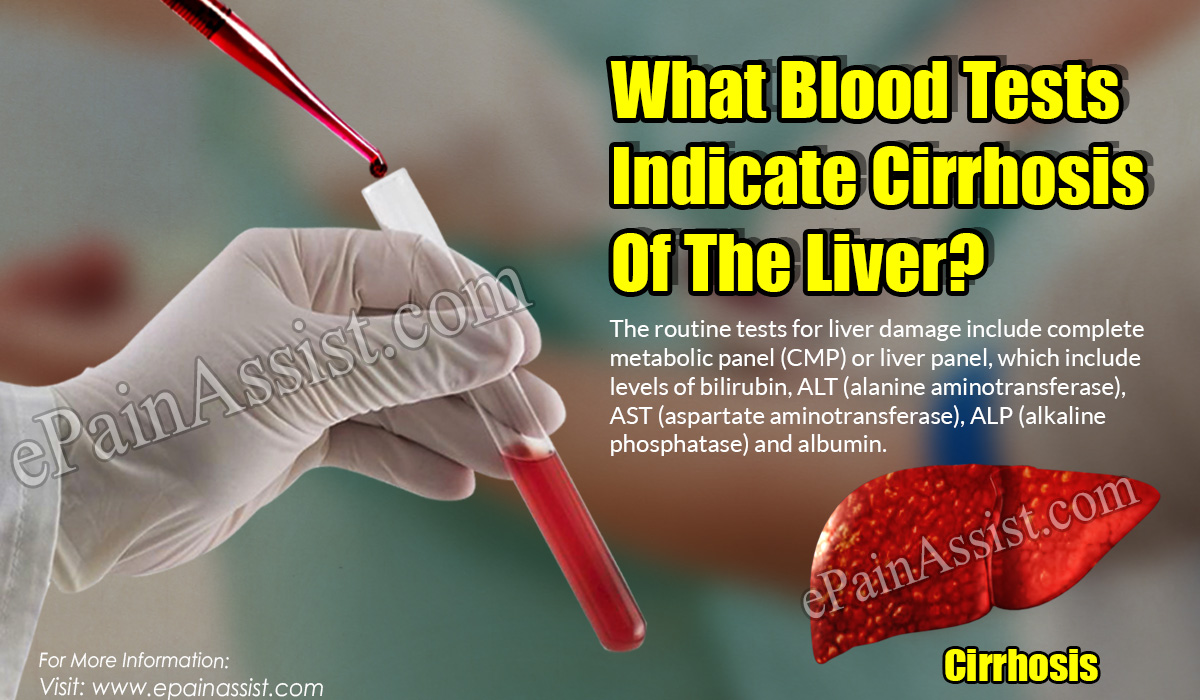Cirrhosis is a chronic and progressive liver damage, which compromises liver function and if not detected early can lead to several complications including liver failure and also death. Since cirrhosis is irreversible and presents with minimal or no symptoms it is mandatory to detect liver damage at an early stage to prevent further liver damage and other complications. Liver has myriad of functions in the body and with cirrhosis these functions are disrupted, thus leading to abnormal results. Blood tests help determine the level of liver injury and its functional capability. Along with blood tests, liver cirrhosis is confirmed with liver biopsy.

What Blood Tests Indicate Cirrhosis Of The Liver?
Routine Testing
The routine tests for liver damage include complete metabolic panel (CMP) or liver panel, which include levels of bilirubin, ALT (alanine aminotransferase), AST (aspartate aminotransferase), ALP (alkaline phosphatase) and albumin. In liver cirrhosis the bilirubin level might be normal or decreased depending on the disease etiology and liver function. ALT, AST and ALP are found in blood in low levels, but in liver cirrhosis/damage their concentration in blood increases. Albumin is one of the proteins synthesized by liver, but in liver cirrhosis the concentration of albumin in blood is decreased due to poor liver functioning. In liver cirrhosis, total serum protein level is also decreased.
The other routine tests include PT (prothrombin time) and CBC (complete blood count). PT is also known as INR (International Normalised Ratio), which is a measure of time taken for a blood clot to form. In liver cirrhosis, PT is increased since liver produces most of the clotting factors and the capability of normal liver function is compromised. CBC is also done along with liver panel in people with suspected liver cirrhosis though it is not a measure of liver function, but is used to evaluate the normal levels of red blood cells (RBCs), white blood cells (WBCs) and platelets. Liver cirrhosis typically presents with decreased levels of platelets (thrombocytopenia) and there might even be anemia if bleeding has occurred. These tests are also used in monitoring the progression of cirrhosis.
Additional Testing
There are additional tests that help determine the cause of liver cirrhosis/damage. Hepatitis B and hepatitis C testing help determine a viral cause. In the presence of ascitis, peritoneal fluid analysis might be done and to assess the level of liver scarring a blood hyaluronic acid test might be ordered. Liver biopsy is done for definitive diagnosis of liver cirrhosis. Genetic tests are also done for inherited liver diseases such as hemochromatosis and Wilson’s disease and iron test also might be done if hemochromatosis is suspected; copper and ceruloplasmin tests if Wilson’s disease is suspected. Alpha 1 antitrypsin helps diagnose the deficiency of the protein and antimitochondrial antibody (AMA) test is done to diagnose primary biliary cirrhosis.
Certain tests are ordered to monitor the development of complications in liver cirrhosis such as ammonia levels rise in end stage cirrhosis with liver failure; des-gamma-carboxy prothrombin (DCP) might be elevated in liver cancer and also alpha-fetoprotein (AFP), which is mildly elevated in liver cirrhosis is markedly elevated in liver cancer.
There are certain scoring system that are based on combination of more than one test and used to determine prognosis and likely liver cirrhosis. These include MELD (model of end stage liver disease) and CTP (Child Turcotte Pugh) scoring system for liver cirrhosis. CTP is generally used to determine life expectancy in individuals with advanced cirrhosis and MELD scoring is also used to assess severity of liver failure and also used for liver transplant consideration of a liver cirrhosis patient. MELD scoring system takes into consideration PT/INR, creatinine (is a measure of kidney function) and bilirubin tests. MELD scoring ranges from 6-40; higher the score more serious is the liver damage.
Along with the above blood tests, other tests such as ultrasound of liver and magnetic or transient elastography (measures liver stiffness) help diagnose certain liver diseases such as nonalcoholic fatty liver disease, liver fibrosis and hepatocellular carcinoma.
Also Read:
- Cirrhosis Of Liver: Causes, Symptoms, Diagnosis, Treatment, Complications
- The 4 Stages of Cirrhosis of Liver
- How Do They Test For Cirrhosis Of The Liver?
- What is a Good Liver Cirrhosis Diet Plan?
- What Not To Eat With Cirrhosis?
- What Are The Final Stages Of Cirrhosis Of The Liver?
- How Serious Is The Cirrhosis Of Liver?
